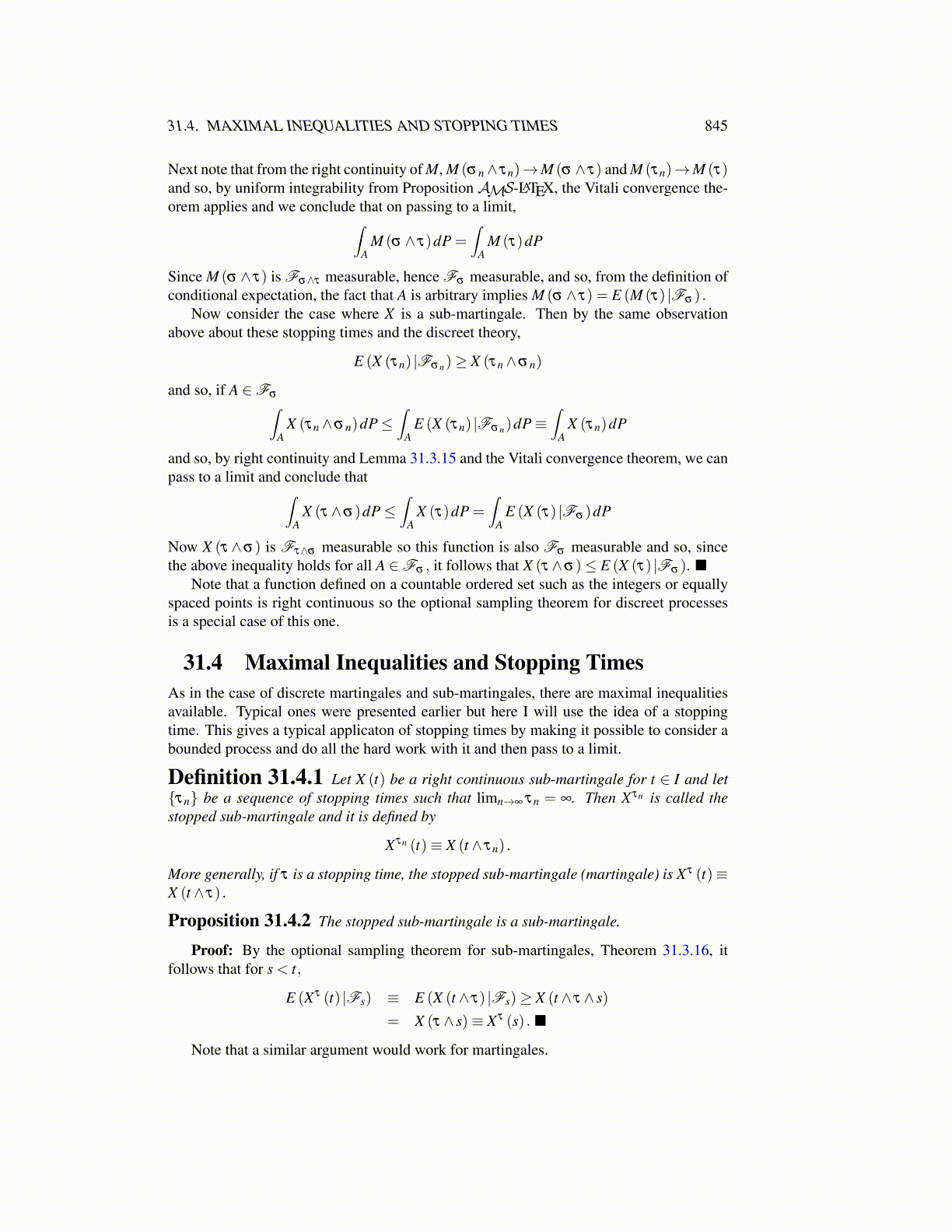
31.4. MAXIMAL INEQUALITIES AND STOPPING TIMES 845
Next note that from the right continuity of M, M (σn∧ τn)→M (σ ∧ τ) and M (τn)→M (τ)and so, by uniform integrability from Proposition AMS-LATEX, the Vitali convergence the-orem applies and we conclude that on passing to a limit,∫
AM (σ ∧ τ)dP =
∫A
M (τ)dP
Since M (σ ∧ τ) is Fσ∧τ measurable, hence Fσ measurable, and so, from the definition ofconditional expectation, the fact that A is arbitrary implies M (σ ∧ τ) = E (M (τ) |Fσ ) .
Now consider the case where X is a sub-martingale. Then by the same observationabove about these stopping times and the discreet theory,
E (X (τn) |Fσn)≥ X (τn∧σn)
and so, if A ∈Fσ∫A
X (τn∧σn)dP≤∫
AE (X (τn) |Fσn)dP≡
∫A
X (τn)dP
and so, by right continuity and Lemma 31.3.15 and the Vitali convergence theorem, we canpass to a limit and conclude that∫
AX (τ ∧σ)dP≤
∫A
X (τ)dP =∫
AE (X (τ) |Fσ )dP
Now X (τ ∧σ) is Fτ∧σ measurable so this function is also Fσ measurable and so, sincethe above inequality holds for all A ∈Fσ , it follows that X (τ ∧σ)≤ E (X (τ) |Fσ ). ■
Note that a function defined on a countable ordered set such as the integers or equallyspaced points is right continuous so the optional sampling theorem for discreet processesis a special case of this one.
31.4 Maximal Inequalities and Stopping TimesAs in the case of discrete martingales and sub-martingales, there are maximal inequalitiesavailable. Typical ones were presented earlier but here I will use the idea of a stoppingtime. This gives a typical applicaton of stopping times by making it possible to consider abounded process and do all the hard work with it and then pass to a limit.
Definition 31.4.1 Let X (t) be a right continuous sub-martingale for t ∈ I and let{τn} be a sequence of stopping times such that limn→∞ τn = ∞. Then Xτn is called thestopped sub-martingale and it is defined by
Xτn (t)≡ X (t ∧ τn) .
More generally, if τ is a stopping time, the stopped sub-martingale (martingale) is Xτ (t)≡X (t ∧ τ) .
Proposition 31.4.2 The stopped sub-martingale is a sub-martingale.
Proof: By the optional sampling theorem for sub-martingales, Theorem 31.3.16, itfollows that for s < t,
E (Xτ (t) |Fs) ≡ E (X (t ∧ τ) |Fs)≥ X (t ∧ τ ∧ s)
= X (τ ∧ s)≡ Xτ (s) . ■
Note that a similar argument would work for martingales.